We test and review fitness products based on an independent, multi-point methodology. If you use our links to purchase something, we may earn a commission. Read our disclosures.
As you get older, it can become more difficult to exercise. Your body isn’t the same as it used to be in your twenties or thirties. Perhaps you’ve also suffered injuries that limit mobility.
Though you may not be able to do what you used to, exercising is still important. Working out regularly may prevent health problems and give you the strength to stay independent. It can also reduce pain and give you more energy throughout the day.
Luckily, you don’t have to run a marathon or lift heavy weights to reap the rewards of exercise. You can do it from your chair at home with little to no equipment. In this article, I’ll explain the benefits of in chair exercises for seniors. Then, I’ll go through my favorite 15 exercises for the upper body, lower body, and core, including how to do them step-by-step. I’ve also included three of the best warm-up exercises to prepare you for the workout.
Medical disclaimer: This article is intended for educational and informational purposes only. It is not intended as a substitute for medical advice. For health advice, contact a licensed healthcare provider.
Maintaining muscle should be a top priority for the elderly population.
Dr. Michael Masi, physical therapist
Benefits of Chair Exercises for Seniors
Before we get into our in chair exercises, let’s go through the top five benefits of chair exercises for seniors. We consulted with Dr. Michael Masi, physical therapist, personal trainer, and owner of Masi Fitness, to explain just why seniors should exercise.
Reduction in Pain
If you experience pain in your daily life (perhaps because you’ve had surgery or injuries in the past), in chair exercises can help reduce this because regular exercise helps to promote pain relief1. “Part of this is because exercise increases serotonin and opiod levels in your brain, which can boost your mood,” Dr. Masi says. Also, you’re lubricating your joints while exercising, as well as keeping the muscles around your joints strong.
Increased Strength
As you get older, you start to lose muscle2. Regularly doing chair exercises can help to build strength, which is vital for everyday activities such as walking, standing up and sitting down, lifting objects, and more. This may help you stay more independent for longer. “The presence of muscle also has an inverse relationship with all-cause mortality,” explains Dr. Masi. “Maintaining muscle should be a top priority for the elderly population.”

Prevents Health Problems
Chair exercises for seniors can help to reduce the risk of cardiovascular events by between 40% and 70%3.
Regular physical activity can help to prevent type 2 diabetes4. “Working out regularly can help lower blood sugar levels,” Dr. Masi says. “As you age, the risk of diabetes diagnoses starts to spike. Exercise can improve insulin sensitivity.
Decreased Risk of Falling
Falls are the leading cause of fatal and nonfatal injuries for adults 65 years of age and older5. The main reasons for falls are a lack of lower body strength, lack of coordination, and instability. Performing in-chair exercises may reduce the risk of falls, reducing the risk of injury.
Increased Confidence
You may not have done any exercise for a long period of time. Beyond the above benefits, the endorphins released during chair exercises can lead to an increase in confidence and lower stress levels. Not only this, but resistance training can also help to significantly improve anxiety symptoms6.
Safety Tips for Chair Exercises
While a chair exercise is typically low-risk, there are a few considerations before you jump in:

- Use a sturdy chair. Doing chair exercises with a wobbly chair can increase the risk of injury. Please don’t use a chair that has wheels!
- Place the chair against a wall. With some exercises, placing the chair against a wall can help to keep it more stable.
- Stop if uncomfortable. If any exercise doesn’t feel right, stop doing it. Either try an alternative exercise or completely stop for the day.
Warm-Up Chair Exercises for Seniors
Before you get going, warm up with some of these movements.
Shoulder Circles
Why do them: They don’t require any equipment and can help to improve mobility in the shoulder joints. “If you’ve ever suffered from rotator cuff injuries, shoulder circles can be a good warm-up before you do exercises involving dumbbells, barbells, or resistance bands,” Dr. Masi says.
How to do them:
- With your chest up and feet flat on the floor, put your arms down to the side of the chair.
- Slowly move your shoulders forward in a circular motion. You’ll need to lift them up and around until you get to the original position.
- Continue for reps, then do the same thing but in a backward circle.

Neck Stretch
Why do it: If you experience neck pain, perhaps because you currently do or used to work at a desk, neck stretches can help to alleviate some of that pain. They can also prevent the neck from stiffening further.
How to do it:
- Sit on the chair with your back against the backrest, and look straight ahead.
- Rotate the head to the left until you feel a stretch and hold.
- Bring the head back to the center and rotate it to the right side. Pause.
- Repeat.
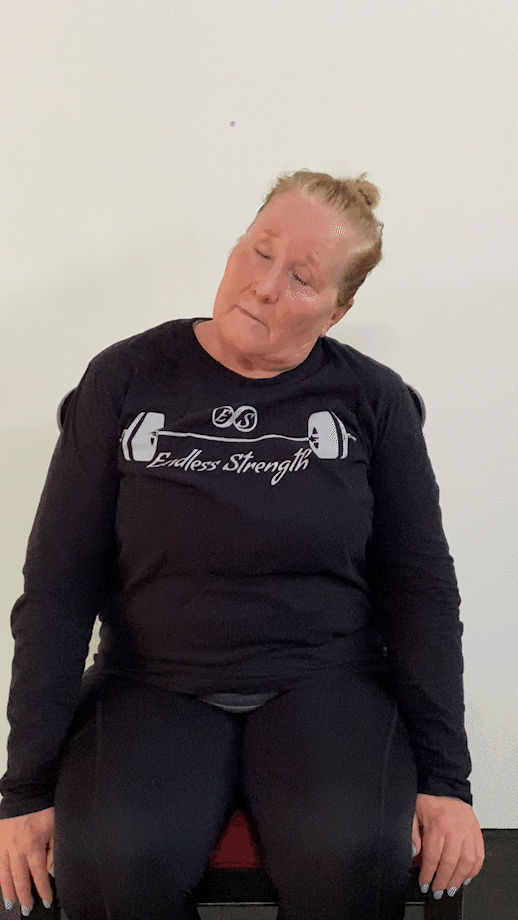
Toe Taps or Toe Raises
Why do them: Toe taps can help to improve strength and flexibility in the ankles, which is a common cause of pain in older adults.
How to do them:
- Place your feet flat on the floor with your knees bent at a 90-degree angle.
- Keeping your heels on the ground, lift your toes up toward the ceiling (if you prefer, you can do one at a time here).
- Hold them, then bring them down and tap them on the floor.
- If this is too easy, sit back in the chair or move your feet further away.
- Repeat for the desired number of repetitions.

Upper-Body Chair Exercises
You can use a pair of the best dumbbells for these exercises, or anything else that has some weight, like cans of soup.
Seated Front Raise
Why do it: The seated front raise activates the front deltoid, which is used to move the arm away from the body. “You use the front deltoid multiple times throughout the day,” Dr. Masi says. “For example, when you hold something up in front of you, reach into cabinets for something, or push open a heavy door.” The seated front raise may also help to improve your posture.
How to do it:
- Take hold of your weights.
- Sit down on the chair with your chest up and feet flat on the floor. Your arms should be hanging at the side of your body (with your palms facing toward you).
- Either one at a time, or both together, lift your arms up in front of your body until they are parallel to the floor.
- Slowly lower your arms back down until you return to the starting position.
- Continue for reps.
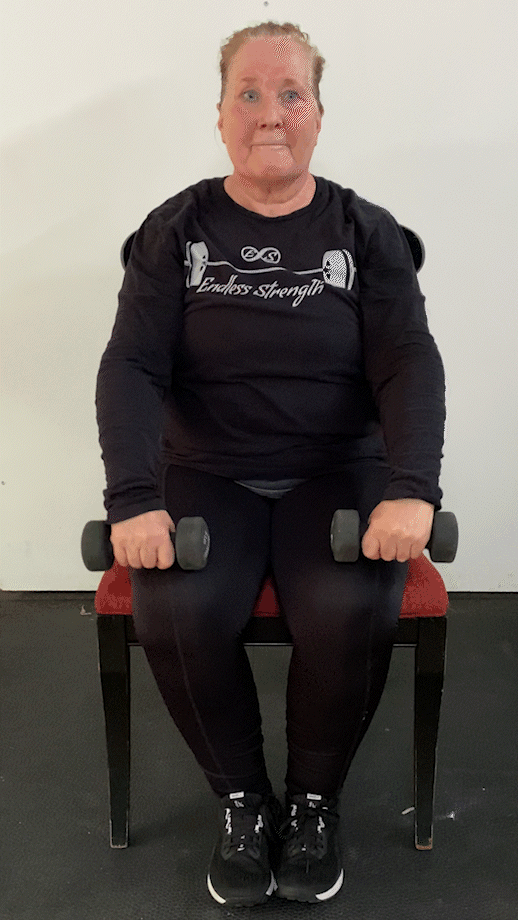
Seated Dumbbell Shoulder Press
Why do it: Seated dumbbell shoulder presses build strength in your shoulder muscles and upper back muscles. You’ll also work your pectorals, triceps, and trapezius. These muscles are used when you have to place objects above your head, such as on shelves or in kitchen cabinets.
How to do it:
- While holding a pair of dumbbells, sit back on a sturdy chair.
- Stick your chest up and engage your core muscles.
- Raise your arms to a 90-degree angle so the dumbbells are resting slightly above your shoulders (with your palms facing away from you).
- Press the dumbbells above your head until your arms are nearly straight. Don’t move your neck here.
- Pause, then slowly lower your arms to the original position.
- Press for the desired number of repetitions.

Seated Bicep Curls
Why do them: You’ll strengthen your biceps and forearms by doing this dumbbell curl variation. Any time you pick something up, you use your biceps, so seated bicep curls can help to make everyday activities easier to do.
How to do them:
- Sitting on a chair, put your arms down to your sides while holding the dumbbells (your palms can either be facing toward you or facing forward).
- Either together or one at a time, curl the dumbbells toward the front of your shoulders.
- Pause for a second, then lower the dumbbells back down, keeping a controlled pace.
- Repeat.

Seated Tricep Extensions
Why do them: “Doing tricep workouts could mean better elbow and shoulder health because the triceps pass both these joints,” Dr. Masi explains.
How to do them:
- Grab a dumbbell and sit down on a chair.
- Wrap both hands around one side of the dumbbell (so your palms are facing toward the ceiling and your hands are in a triangular shape).
- Move your arms so the dumbbell is behind your head.
- Tuck your elbows in and stick your chest out.
- Now, straighten your arms until they’re directly above your head.
- Slowly lower the dumbbell down, and continue for the desired reps.

Seated Chest Press
Why do it: What’s an exercise program without a chest exercise? The chest is one of the biggest muscle groups in the human body and has a variety of functions. This includes pushing the arms away from the body7. A stronger chest may lead to a better posture.
How to do it:
- Attach a resistance band around the back of the chair so that it’s at shoulder height (you can use a door for this).
- In a seated position, take hold of the handles with your palms facing downward. Sit upright.
- Place your hands so that they’re just outside of your pectorals (right arm on the right side and left arm on the left side).
- Push your arms in front of you until they’re straight.
- Return them slowly to the original position.
- Repeat.

Push-Ups to Chair (or Elevated Push-ups)
Why do them: A modified version of one of my favorite bodyweight exercises (the regular push-up), the push-up to chair is a great way to work the chest, shoulders, triceps, core, and more. Dr. Masi says, “This is a more advanced version of the seated chest press, so when you feel you are ready, you can either switch to these, or do a few of these as tolerated, then finish your remaining reps with the easier chest press variation.”
You can also scale this workout to be harder by using a lower chair, or easier by using a higher chair.
How to do them:
- Make sure the chair is secure against a wall and won’t move.
- Stand up straight close to the seat of the chair.
- Place your right hand on the right side of the seat, and your left hand on the left side.
- Step back so that you’re in a plank with your legs straight. This will be your starting position.
- With your elbows close to your body and your core engaged, bend your arms so that your body goes toward the seat.
- Push to the original position, then continue for reps.
RELATED: What Muscles Do Push-Ups Work?

Lower-Body Chair Exercises
Again here, you may use a pair of dumbbells or any other weighted item, like resistance bands, kettlebells, soup cans, or a milk jug when prompted to hold weight.
Sit-to-Stand
Why do it: The sit-to-stand exercise enhances muscle strength and reduces lower body muscular demands in physically frail elders8. If you’ve ever had surgery (for example, knee or hip surgery), this exercise can be particularly helpful. Add dumbbells or a weight for extra resistance.
How to do it:
- Sit down on the edge of the chair with your feet shoulder-width apart.
- With your chest up, put your arms out in front of you if you don’t have weight, or hold the weight close to your chest.
- Look straight ahead.
- Stand up from the chair slowly until you’re fully upright (your extended arms will help you to balance). Try not to move your feet and squeeze your glutes as you stand up.
- Slowly sit back on the chair, rest, then repeat.
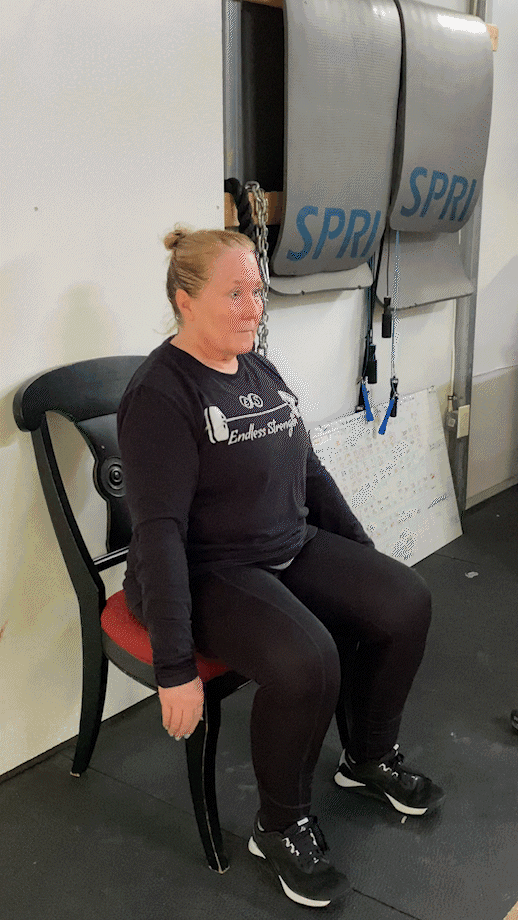
Squat to Chair
Why do it: The squat-to-chair is a more advanced version of the sit-to-stand exercise above. Because you don’t sit down, it’s slightly more difficult. This means that there will be more activation of your quads, hamstrings, calves, glutes, core, and more.
How to do it:
- Stand upright close to the front of the chair, but facing away from it.
- Adjust your feet so that they’re shoulder-width apart and stick your chest up (your toes should be either straight or pointing slightly outwards).
- Engage your core, and then squat down towards the seat of your chair.
- Tap the chair with your glutes but don’t sit down.
- Push into your feet to return to the original position (you’ll need to use your quads and hamstrings here).
- Continue for the desired number of reps.
RELATED: How to Do Goblet Squats

Leg Extensions
Why do them: For those with limited mobility or if you’ve had an injury in the left or right knee, chair leg extensions can be a good exercise to strengthen the quadriceps. You use your quads to walk, climb stairs, sit and stand, and much more. Plus, they’re the largest muscle group in the human body9.
How to do them:
- Hold the sides of the chair with both hands while seated on it.
- Move your feet so that your legs are at a 90-degree angle (and are hip-width apart).
- With your left leg, straighten it out until it’s fully extended (your right leg shouldn’t move here).
- Return your left leg to the start, then do the same with your right leg.
- Keep alternating until you’re finished.

Seated Calf Raises
Why do them: Seated calf raises strengthen the calf muscles. You use your calves every day for activities such as walking, climbing stairs, squatting, and standing up. “Strong calves help stabilize your ankles, which is very important for balance and reducing risk for falling,” says Dr. Masi.
You can advance this movement by putting weights on your thighs just above the knee, or place your toes on a book to get a deeper range of motion.
How to do them:
- Sit down on the chair with your back against the backrest.
- Hold the sides of the seat with both hands.
- Place your feet flat on the floor with your legs at a 90-degree angle.
- while keeping your toes firmly on the floor, lift both heels up towards the ceiling.
- Pause, then return your heels to the floor.
- Repeat for repetitions.
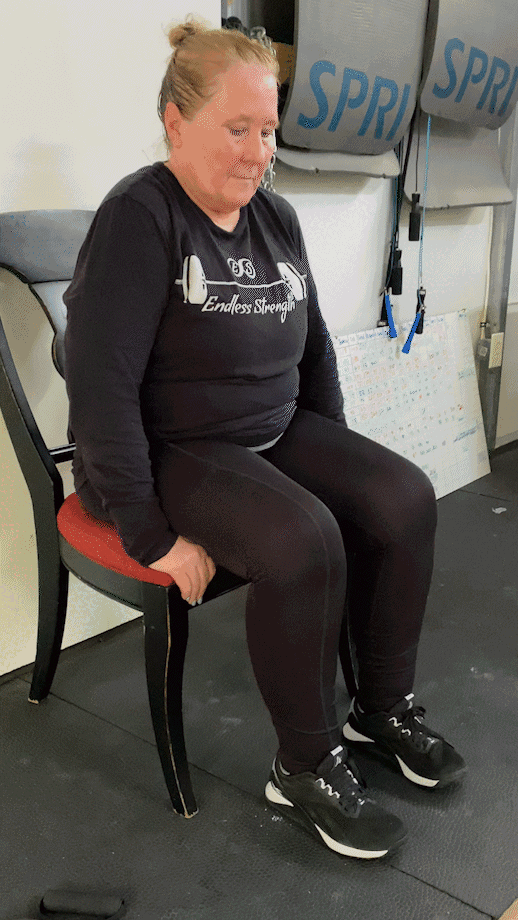
Seated Heel Slides
Why do them: Heel slides help to increase the range of motion in your knees, which is ideal if you’ve had any type of knee or hip surgery. They don’t require any equipment, and doing this exercise regularly may help improve or maintain good flexibility in your knees, which is especially needed for squatting and descending stairs.
How to do them:
- Get seated on the edge of the chair.
- Extend your left leg out until it’s straight (your toes should be facing toward the ceiling but your left heel should still be on the ground).
- Place your right foot flat on the floor and at a 90-degree angle.
- With your left leg, slide your left heel as close to the chair as possible, and at the same time, place your left foot on the floor.
- Slide for reps, then repeat with your right leg.

Core Chair Exercises
Yes, you can work your core muscles doing in-chair exercises! Try these movements, which are modifications of the best ab exercises.
Modified Plank
Why do it: Planks work the rectus abdominis muscles, transverse abdominis muscles, and the obliques. Additionally, you use your legs, arms, glutes, and more to hold the plank, making them a great full-body exercise. Seniors who suffer from back pain may benefit from planks.
How to do it:
- Make sure the chair is securely placed against a wall.
- Stand upright, facing the chair.
- Start by placing both hands on the edge of the seat.
- Now, move your feet backward until your body is in a straight line and you’re in the plank position (keep your head neutral and squeeze your glutes).
- Breathe in to engage your core and hold for the desired length of time.
- Repeat.
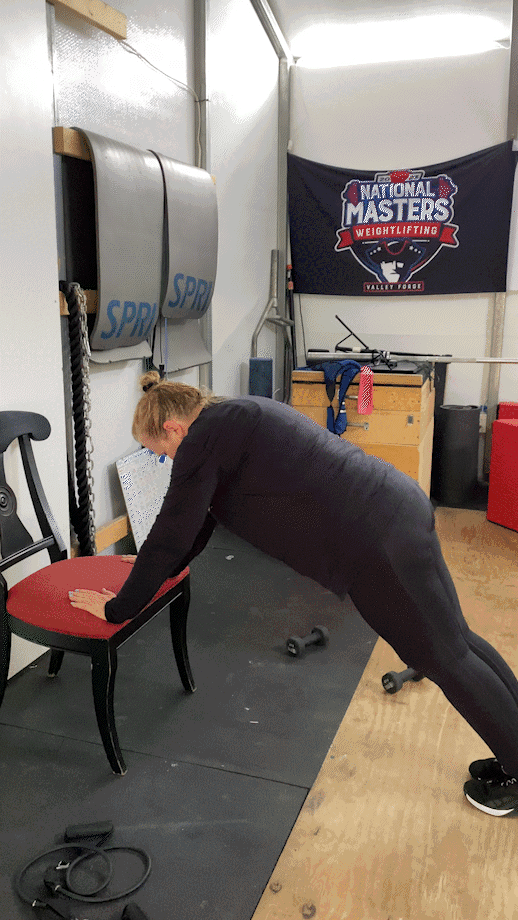
Leg Raises
Why do them: Leg raises work muscles throughout your core, but especially the lower abdominals and hip flexors. You’ll also engage your hamstrings, lower back, and hip flexor muscles. If done regularly, they can help to reduce back pain and lower the risk of back injuries.
How to do them:
- Take hold of the sides of the chair with both hands while sitting close to the edge.
- Lean back slightly and extend both legs outward (your heels should be touching the ground and your toes facing toward the ceiling).
- Engage the core and lift both legs toward the ceiling (you can also do this one leg at a time).
- Pause for a few seconds, then lower the legs down.
- Raise for reps.

Knees to Chest
Why do it: It’s a good exercise for the entire core, but especially the lower abdominal muscles. You use your core to sit, stand, walk, bend, and many other daily activities, so this exercise can help make daily life easier.
How to do it:
- while seated, lean back slightly and hold the sides with both hands.
- Breathe in to activate the core and extend the legs outwards so that they’re off the ground (your toes should be pointing toward the ceiling). If this is too difficult, touch your heels onto the floor.
- Bring your knees to your chest by bending them.
- Once you can’t get closer to the chest, pause, then reverse the motion.
- Continue until you’re done.

Seated Twists
Why do it: The seated twist works the lower back, obliques, and abs. It can also help to improve spinal mobility and posture, which is something that can help adults who have spent years sitting at a desk.
“Start gently with this exercise as you figure out your range of motion,” warns Dr. Masi. “Twisting activities can be great, but if you have a history of back injury, slowly turn to your comfort level.”
How to do it:
- Sit down on a sturdy chair with your back straight (don’t sit against the backrest).
- Place your hands across your chest.
- While keeping your glutes on the chair, slowly rotate your body to the left as far as possible.
- Hold, then return to the center of your chair.
- Now, slowly rotate to your right.
- Keep rotating until you’ve reached the desired repetitions.
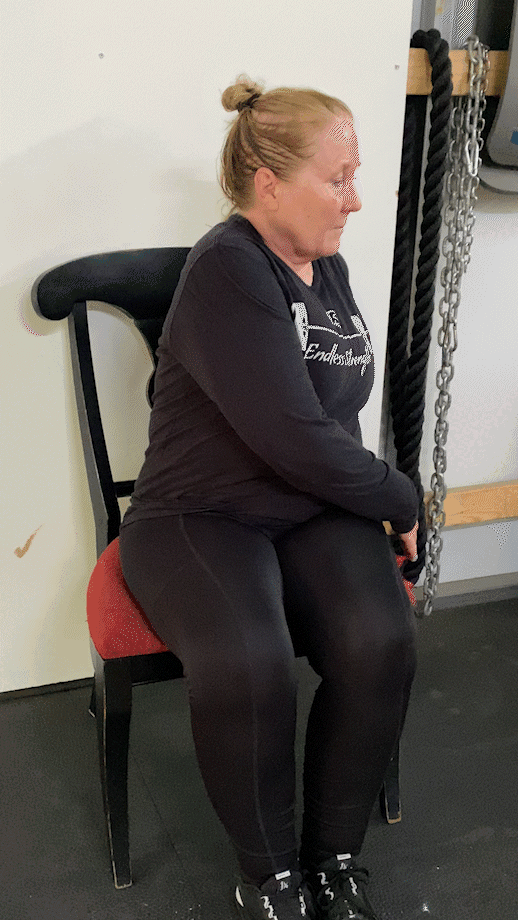
Chair Exercises: Final Thoughts
Exercising regularly as you get older can have a ton of benefits, including increased strength, reduced risk of falling, and less pain. Our 15 in-chair exercises are designed to help you reap the benefits of exercising without breaking your back.
In Chair Exercises: FAQs
What exercises can I do while sitting in a chair?
While sitting in a chair, you can do a range of exercises, including shoulder circles, While sitting in a chair, you can do a range of exercises, including shoulder circles, toe taps, dumbbell shoulder presses, chest presses, sit-to-stands, calf raises, knees to chest, leg raises, and many more.
How effective are chair exercises?
Chair exercises can be effective for both resistance and cardiovascular training because it can build strength and increase your heart rate. If done consistently over a period of time, you may be able to increase your strength, improve cardio endurance, reduce pain in certain areas, and even improve your confidence. As you get older, the risk of falling increases and chair exercises can decrease the risk of this happening.
How can I exercise while sitting down?
You can do a ton of exercises while sitting down, depending on the equipment you have. If you have no equipment (except the chair, of course!), you can do modified planks, squats to chair, push-ups to chair, neck stretches, and more. If you’re going to be regularly exercising while sitting down, I’d recommend buying some dumbbells or resistance bands as this will increase the number of exercises you’re able to do.
What is the simple chair exercise for seniors?
With a chair, you can do simple sitting or standing exercises. Examples of simple chair exercises for seniors include seated twists, heel slides, leg extensions, bicep curls, tricep extensions, and more.
How often should seniors do chair exercises?
Seniors can do chair exercises as many times as they want to per week, but I’d suggest three to five times a week minimum to see the benefits. Each session should include a range of exercises (around six to eight) and last around 30 to 45 minutes in total. If you’re going to do fewer chair exercises in total each time, you could even do them daily for a shorter period of time.
What exercise should a 70-year-old be doing?
The exercise a 70-year-old should be doing depends on his or her fitness levels. If you’re still able to go to the gym or work out from home, do so. If you’re not able to and prefer doing a chair workout, you can do this instead. Regular walking is also a good way a 70-year-old can exercise.
References
- Lima LV, Abner TSS, Sluka KA. Does exercise increase or decrease pain? Central mechanisms underlying these two phenomena. J Physiol. 2017 Jul 1;595(13):4141-4150. doi: 10.1113/JP273355. Epub 2017 May 26. PMID: 28369946; PMCID: PMC5491894.
- Volpi E, Nazemi R, Fujita S. Muscle tissue changes with aging. Curr Opin Clin Nutr Metab Care. 2004 Jul;7(4):405-10. doi: 10.1097/01.mco.0000134362.76653.b2. PMID: 15192443; PMCID: PMC2804956.
- Liu Y, Lee DC, Li Y, Zhu W, Zhang R, Sui X, Lavie CJ, Blair SN. Associations of Resistance Exercise with Cardiovascular Disease Morbidity and Mortality. Med Sci Sports Exerc. 2019 Mar;51(3):499-508. doi: 10.1249/MSS.0000000000001822. PMID: 30376511; PMCID: PMC7385554.
- Aune D, Norat T, Leitzmann M, Tonstad S, Vatten LJ. Physical activity and the risk of type 2 diabetes: a systematic review and dose-response meta-analysis. Eur J Epidemiol. 2015 Jul;30(7):529-42. doi: 10.1007/s10654-015-0056-z. Epub 2015 Jun 20. PMID: 26092138.
- Shaw, T, Sergent, A, Lorentz, D. Resistance training for fall prevention: a narrative review of the literature. JIAMN. 2022. 19(1):3-9.
- Gordon BR, McDowell CP, Lyons M, Herring MP. The Effects of Resistance Exercise Training on Anxiety: A Meta-Analysis and Meta-Regression Analysis of Randomized Controlled Trials. Sports Med. 2017 Dec;47(12):2521-2532. doi: 10.1007/s40279-017-0769-0. PMID: 28819746.
- Solari F, Burns B. Anatomy, Thorax, Pectoralis Major Major. [Updated 2022 Jul 25]. In: StatPearls [Internet]. Treasure Island (FL): StatPearls Publishing; 2023 Jan-. Available from: https://www.ncbi.nlm.nih.gov/books/NBK525991/
- Fujita E, Taaffe DR, Yoshitake Y, Kanehisa H. Repeated sit-to-stand exercise enhances muscle strength and reduces lower body muscular demands in physically frail elders. Exp Gerontol. 2019 Feb;116:86-92. doi: 10.1016/j.exger.2018.12.016. Epub 2018 Dec 27. PMID: 30593854.
- Bordoni B, Varacallo M. Anatomy, Bony Pelvis and Lower Limb: Thigh Quadriceps Muscle. [Updated 2022 May 10]. In: StatPearls [Internet]. Treasure Island (FL): StatPearls Publishing; 2023 Jan-. Available from: https://www.ncbi.nlm.nih.gov/books/NBK513334/
Further reading

Pre-workout is a staple for gym-goers, but does pre-workout expire and go bad? Learn from an expert how long pre-workout lasts, signs it’s gone bad, and what to do with expired products. Read more

Ghost reached into the most nostalgic corners of your brain and created a pre-workout with flavors you know by heart, and the energy and pumps you crave. Read more
What should my macros be? A registered dietitian explains how to determine your macros based on your fitness goals! Read more

Is the super greens powder from Live It Up worth it? The GGR nutrition experts cover everything you need to know in our Live It Up Super Greens review! Read more

